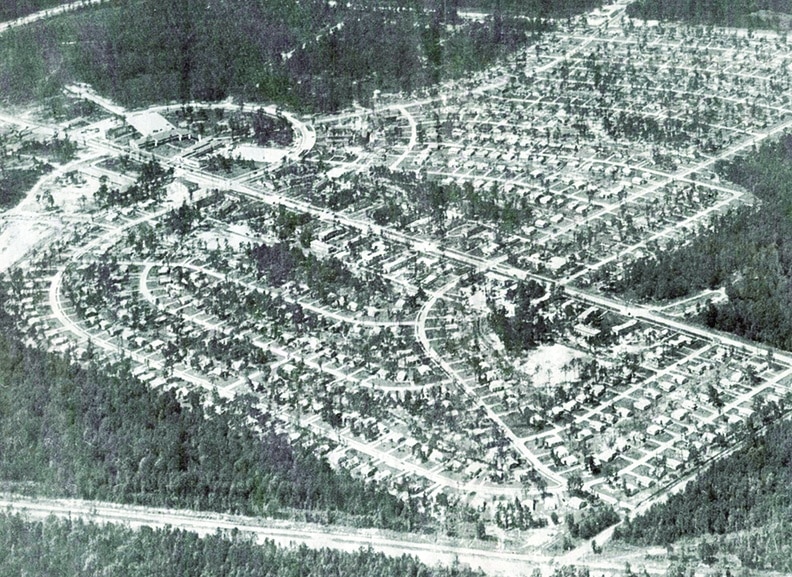Maplewood Began As A Community Completely Different From Surrounding Cities
By Danny Garrett
The area of Maplewood, just east of Sulphur, was created in 1940-41 as a way to provide housing for the massive industrial expansion that accompanied the United States’ entry into WWII.
Already established in the area was Mathieson Alkali Plant, built in 1934, and Continental Oil near Westlake. Soon after Pearl Harbor, however, what’s been called the most massive industrial expansion in U.S. history saw the establishment of the Cities Service Oil Col refinery, the butadiene plant, operated by Cities Service, to supply synthetic rubber to Firestone Tire and Rubber plant, and a new nitric acid plant at Mathiesron. When all was said and done, some $200 million was invested in industrial plants between Lake Charles and Sulphur during WWII.
Which put the area in a similar situation as the one it’s in today: where are all of the workers needed going to live?
John W. Harris Associates, a local construction firm, had the answer. The firm approached Cities Service with a proposal to provide a planned housing project for the plant. The plant advanced Harris $1 million to get the project started, and also sold the company 295 acres located eight miles west of Lake Charles and three miles east of Sulphur along Hwy. 90. This tract of land would become the community of Maplewood.
When completed, the development would contain 790 residential units, including 402 three-bedroom homes, 180 two-bedroom homes, 38 two-bedroom duplex structures, and eight one-bedroom duplex buildings. There were also apartments.
“Maplewood was a social experiment, although it was not primarily intended as such,” wrote Thomas R. Ford in a 1948 sociology thesis for LSU.
‘Mud Up To Our Ankles’
For the many families relocating to the new community from areas in the Northeast, Maplewood must have been quite a shock. The community was created in the middle of a low area., and construction workers, mostly from New York, building the first houses in the area worked in up to six inches of mud that first winter of construction, swatted mosquitoes and dealt with cattle and mules crossing into the land, despite cattle guards.
Those first residents dealt with a lack of streets, and an abundance of cows, mules and pigs milling around.
Pigs were commonly found rooting under houses, wrote one early resident, and cows wandered through yards eating flowers.
“There was mud up to our ankles,” wrote one early resident. “There were no streets, just lots of mules, cows and hogs roaming freely around, when we first came here in 1943.”
“Men splashed around in high rubber boots,” wrote another. “Horseback riders galloped up and hitched their horses to nearby trees. Mud-spattered cars wove in and out bearing license plates of many different states. It reminded me of the ‘49ers and the Gold Rush.”
“Maplewood had no roads and mud was everywhere,” wrote yet another early resident, who arrived in 1943 from Trinidad, Col. “There were so many mules because there was a mule barn right next to the school. The mules drew flies like mad, and there were no screens on the school windows. We really got a dose of pioneering in those years.”
Without exception, however, despite those hardships of Maplewood’s early years, each of those early residents also described their time in Maplewood as “the best time of my life.”
The first residents of Maplewood are considered to be Mr. and Mrs. Charles Banzhof, who moved in on Oct. 22, 1943, from New Jersey. Indeed, most of Maplewood’s early residents relocated there from the Northeast, and what a shock it must have been for them — those first mules and pigs milling around.
A Community Develops
The first store in Maplewood was a long, one-story warehouse and general store. There was also a hardware store located nearby, and the local post office was located in someone’s home.
The community’s first newspaper, The Maplewood Star, followed in 1944, edited and owned by Beatrice North, who had come to Maplewood with her husband, Robert, a supervisor at Cities Service. The first seven issues of the paper were mimeographed rather than printed.
Just how Maplewood got its name is unclear. Some say that John Work, first manager of the Maplewood Housing Company, created by Harris firm to oversee the community, coined the name. Others say the name came from a small creek running through a grove of maple trees in the development.
A Military Presence In Maplewood
In 1944, the Civic Council of Maplewood was formed. It tried to elect a mayor, which was illegal, as Maplewood wasn’t an incorporated area. However, a man named Carpenter was elected, and he began a serious campaign to have the rents in Maplewood lowered. He went so far as to threaten a strike at Cities Service unless rents were lowered.
Most men in the Civic Council wanted to avoid a strike, nevertheless Cities Service was notified that unless rents were lowered by 10 am Tuesday, March 20, 1945, enough employees would strike that it would become impossible to operate the plant.
Cities Service responded that it had no control over the rents charged in Maplewood.
Gov. Jimmy Davis was asked to request federal intervention. President Truman sent a representative of the Petroleum Administration to mediate, and Interior Secretary Harold Ickes issued a request for workers to stay on the job. But the strikers did leave their jobs, and on the night of April 11, 1945, 150 armed military police from the Army’s Eighth Service Command were moved into Cities Service. In a ballot taken six days later, the workers voted two-to-one in favor or returning to work.

















Comments are closed.